How Long Do Oysters Last in the Fridge
Your fresh oysters will last 7-10 days in the refrigerator when stored properly at 38°F (3.3°C), though you'll get the best flavor within the first 4 days. Store live oysters cup-side down in an open container covered with a damp cloth, and keep shucked oysters in their liquid in an airtight container. Check daily that shells are tightly closed or close when tapped, discarding any that remain open, have broken shells, or emit foul odors. Maintain proper temperature between 35-40°F, and don't let them sit in standing water. Understanding proper storage techniques can markedly extend your oysters' freshness and safety.
This post may contain affiliate links. If you make a purchase through these links, I may earn a commission at no additional cost to you. Additionally, portions of this post may be generated using artificial intelligence (AI) technology. While we strive for accuracy, please be aware that AI-generated content may not always be perfect and should be fact-checked when necessary.
The Spatula Scoops
- Live oysters maintain optimal freshness for 4 days but can last up to 7-10 days when properly refrigerated at 35-40°F.
- Fresh shucked oysters should be consumed within 4-5 days when stored in their liquor in an airtight container.
- Store live oysters cup-side down in the refrigerator, covered with a damp cloth, and avoid airtight containers.
- Check daily for spoilage signs like foul odors, open shells that won't close, or discolored meat.
- Maintain temperature between 35-40°F (1.7-4.4°C), with 38°F (3.3°C) being the ideal storage temperature.
Live Oysters Storage Duration
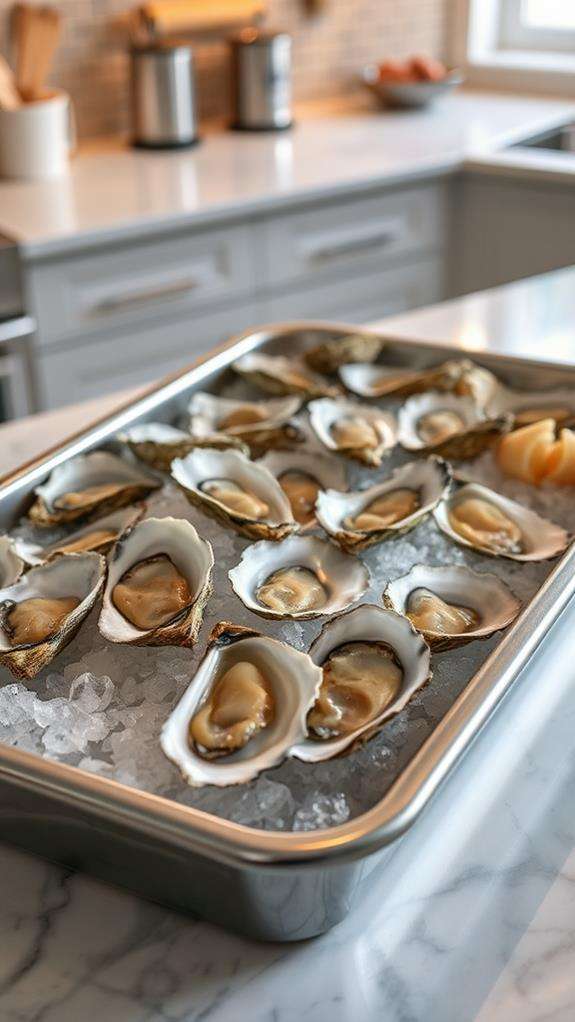
Storing live oysters properly is essential for both safety and taste. When you've purchased fresh, live oysters, you'll want to keep them in your refrigerator where they can survive for 7-10 days, though you'll get the best flavor if you eat them within the first 4 days.
You'll need to store your oysters at a temperature between 35-40°F (1.7-4.4°C), and they must be kept alive until you're ready to consume them. Don't store them in airtight containers or plastic bags, as they'll suffocate. Instead, place them cup-side down in an open container, covered with a damp cloth or paper towel. This method helps maintain the oysters' natural moisture while allowing them to breathe.
Before storing, you should check that all your oysters are alive by ensuring their shells are tightly closed or that they close when tapped. If you find any oysters with broken shells or ones that don't close when touched, you'll need to discard them immediately. Remember to regularly check your stored oysters and remove any that have opened or developed an off-putting smell.
Storing Fresh Shucked Oysters
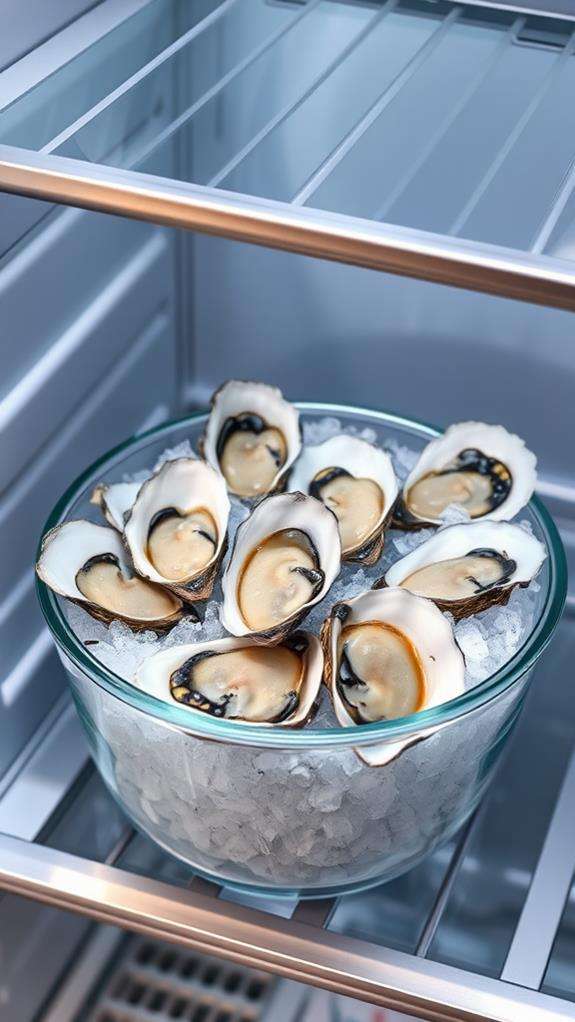
Fresh shucked oysters require different handling than their live counterparts. Once you've removed an oyster from its shell, you'll need to store it properly to maintain its freshness and prevent bacterial growth. Shucked oysters should always be kept in their own liquid (known as liquor) in an airtight container.
When storing fresh shucked oysters, follow these essential guidelines:
- Keep them at a consistent temperature between 32-40°F (0-4°C) in the coldest part of your refrigerator
- Store them in a sealed container with their natural liquor, making sure they're completely submerged
- Use food-grade containers specifically designed for seafood storage, avoiding metal containers that can affect taste
You can expect properly stored shucked oysters to last 7-10 days in the refrigerator, but it's best to consume them within the first 4-5 days for the best flavor and texture. You'll know they're still good if they maintain their natural gray color and smell fresh like the ocean. If you notice any strong fishy odors or discoloration, it's time to discard them. Always check the "best by" date on commercially shucked oysters and follow the manufacturer's storage instructions.
Proper Refrigeration Temperature
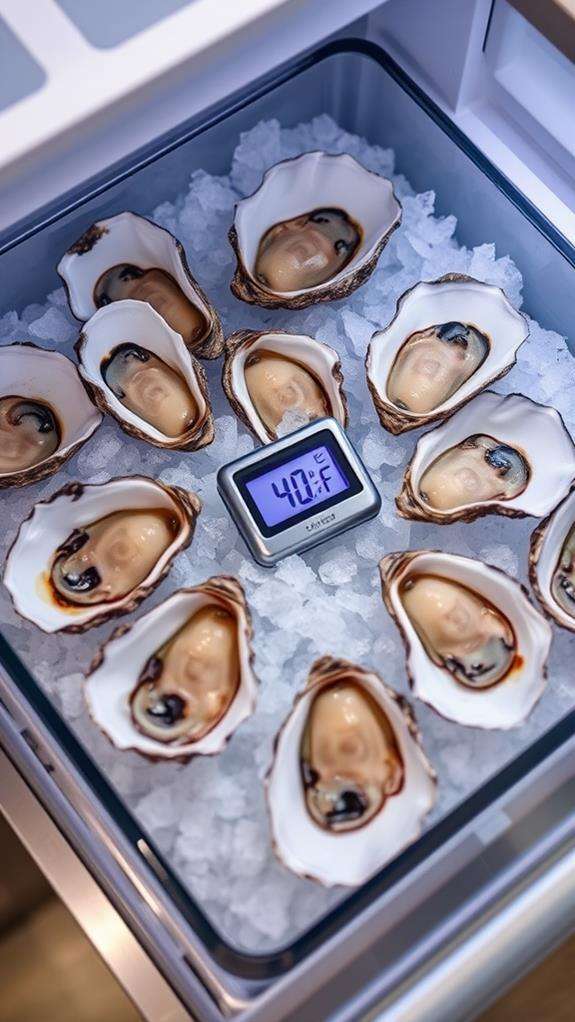
Maintaining the correct temperature is critical for keeping oysters safe and fresh in your refrigerator. You'll want to set your fridge between 35°F and 40°F (1.7°C to 4.4°C), with 38°F (3.3°C) being the ideal temperature for best preservation.
To guarantee you're hitting these temperature targets, you'll need to use a reliable refrigerator thermometer, as your fridge's built-in dial settings aren't always accurate. Place the thermometer in the center of your refrigerator's main compartment, where you'll store your oysters. Don't store them in the door compartments, where temperatures can fluctuate each time you open the fridge.
You should also consider the location of your oysters within the refrigerator. Place them on the bottom shelf, where it's typically coldest, but make sure they're not pushed against the back wall where they might freeze. If you're using a drawer, choose the one designated for meats and seafood, as these compartments are designed to maintain consistently cold temperatures. Remember to check your thermometer daily, especially during summer months when your fridge works harder to maintain proper cooling.
Signs of Spoiled Oysters
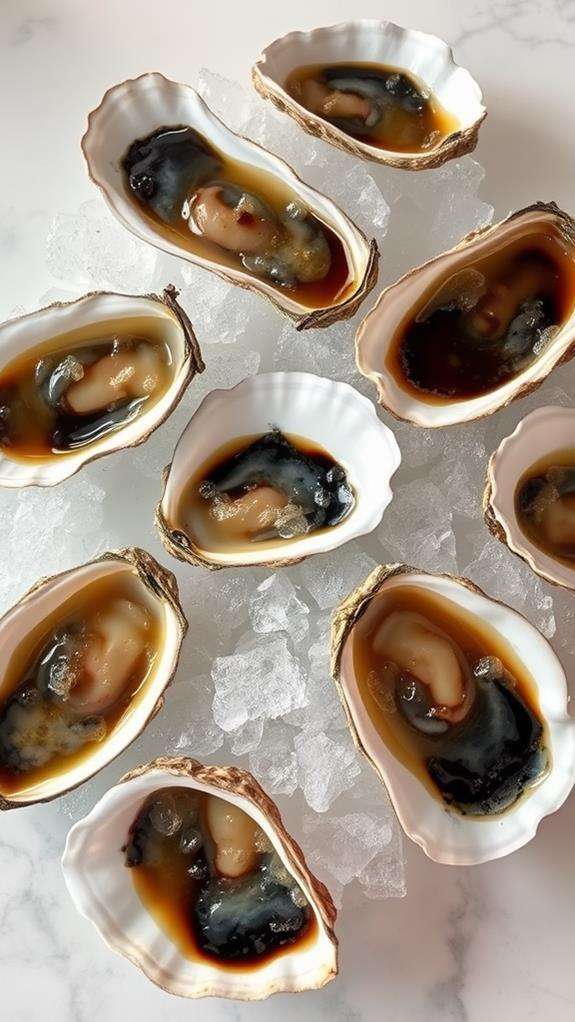
Knowing when oysters have gone bad can save you from a nasty case of food poisoning. You'll need to carefully inspect your oysters before consumption, paying close attention to their appearance, smell, and shell integrity.
When examining your oysters, look for these critical warning signs:
- Foul or unusually strong odors that don't match the typical briny, ocean-like smell of fresh oysters – if you detect anything resembling rotten eggs or an ammonia-like scent, it's time to discard them
- Shells that remain open and don't close when tapped or handled – living oysters will naturally close their shells when disturbed, so unresponsive shells often indicate death and spoilage
- Discolored meat that appears dark, dry, or has unusual spots – fresh oyster meat should be plump, moist, and maintain a creamy tan or light gray color
You'll also want to check for damaged or cracked shells, which can allow bacteria to enter and accelerate spoilage. If the oyster's liquor (the natural juice inside) appears cloudy or has an unusual consistency, don't take any chances. When in doubt, it's always safer to throw questionable oysters out.
Best Storage Container Options
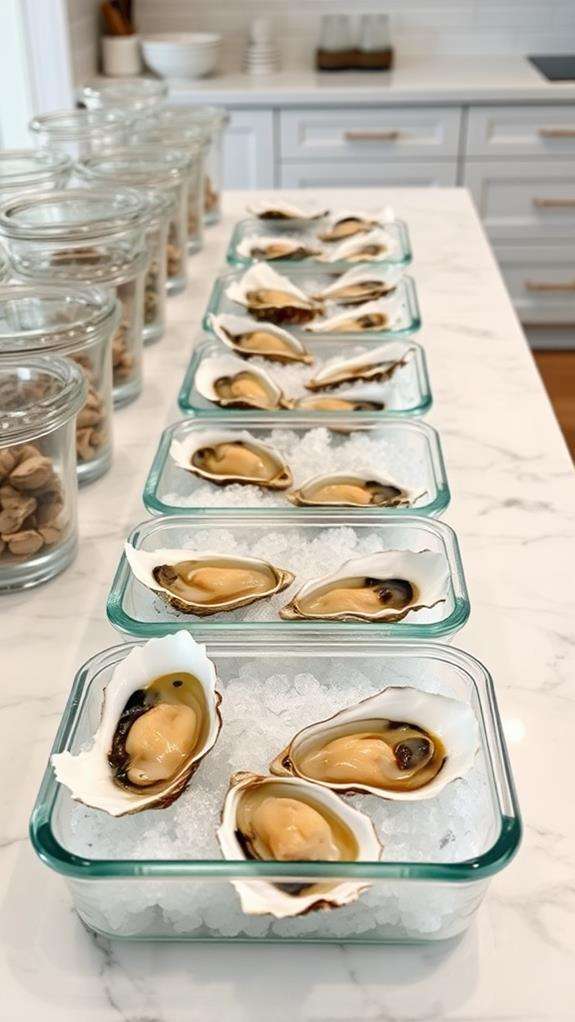
After identifying spoiled oysters, proper storage containers play a key role in maximizing shelf life. You'll want to select containers that maintain temperature consistency while allowing your oysters to breathe, as these bivalves are living creatures that need oxygen to survive.
The best primary storage option is a mesh bag or breathable container with holes, which you can place on a bed of ice in a larger container. If you don't have a mesh bag, you can use a perforated plastic container or a colander set inside a larger bowl. Make sure there's proper drainage, so your oysters aren't sitting in melted ice water.
For the outer container, use a deep plastic or stainless steel bowl with enough space for ice beneath the perforated inner container. You'll want at least two inches of space between the oysters and the bottom of the bowl. Don't use airtight containers or sealed plastic bags, as these will suffocate your oysters. If you're storing pre-shucked oysters, however, you can keep them in an airtight container filled with their liquor (natural juice).
Freezing Oysters For Later
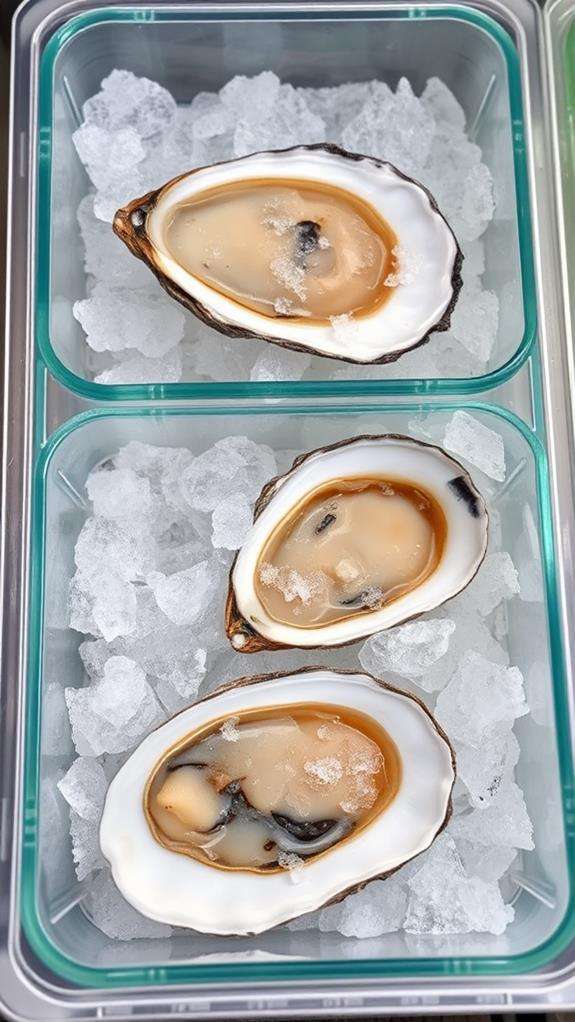
While fresh oysters taste best, you can freeze them for extended storage when you can't eat them right away. The freezing process will change their texture slightly, but they'll remain safe to eat for up to six months when properly stored. You'll want to freeze them in their liquor (natural juices) to maintain ideal flavor and prevent freezer burn.
To successfully freeze your oysters, follow these essential steps:
- Thoroughly clean the oysters under cold running water, discarding any that are already open or damaged
- Shuck the oysters carefully, preserving the natural liquor, and place them in freezer-safe containers or heavy-duty freezer bags
- Leave about 1/2 inch of headspace in containers for expansion, seal tightly, and label with the date
When you're ready to use your frozen oysters, transfer them to your refrigerator and let them thaw overnight. Don't attempt to speed up the process by thawing at room temperature, as this can promote bacterial growth. Once thawed, you'll find these oysters work best in cooked preparations like stews, chowders, or other hot dishes rather than being served raw.
Extending Oyster Shelf Life
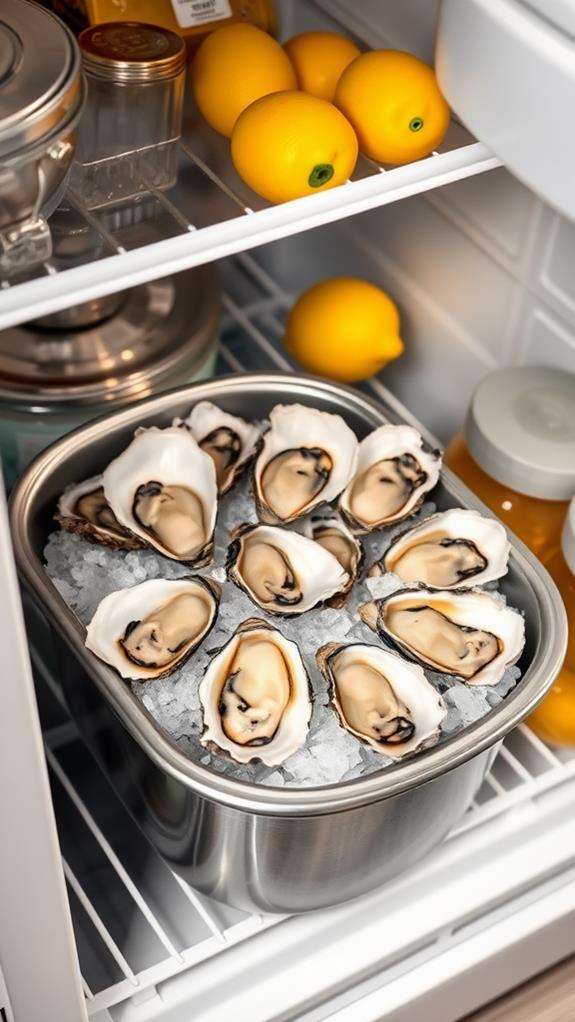
Beyond freezing, you can maximize the freshness of your refrigerated oysters through proper storage techniques. Store them cup-side down on a flat surface, covering them loosely with a damp cloth to maintain moisture while allowing air circulation. You'll want to keep the temperature between 35-40°F (1.7-4.4°C), which is perfect for preserving their quality.
To further extend shelf life, don't store your oysters in airtight containers or plastic bags, as they need to breathe. Instead, place them in a colander or mesh bag inside a bowl to catch any draining liquid. You'll also want to check them daily, removing any that have opened or show signs of damage. When you're handling the oysters, make sure your hands are clean to prevent bacterial contamination.
For peak freshness, store your oysters away from strong-smelling foods, as they can absorb odors. You should also avoid washing them before storage – just brush off any loose debris. If you're planning to keep them longer than a week, consider shucking and freezing them instead, as this will better preserve their quality for extended periods.
Safe Handling Guidelines

Safe handling of oysters begins with selecting fresh specimens at the market. You'll want to verify they're tightly closed or that they close when you tap them, indicating they're still alive. When transporting your oysters home, keep them cold and moist, but never let them sit in standing water.
Once you've got your oysters home, follow these critical handling guidelines:
- Store them cup-side down in your refrigerator at 40°F or below, preferably on a bed of ice with holes for drainage, and cover them loosely with a damp cloth to maintain moisture
- Wash your hands thoroughly before handling oysters, and clean all preparation surfaces and tools with hot, soapy water to prevent cross-contamination
- Scrub the outer shells with a stiff brush under cold running water before shucking to remove any debris or bacteria
Don't store oysters in airtight containers or plastic bags, as they need to breathe. You'll also want to check them daily, discarding any that have opened and won't close when tapped. Remember to handle raw oysters with care to minimize the risk of foodborne illness.
From Market To Fridge
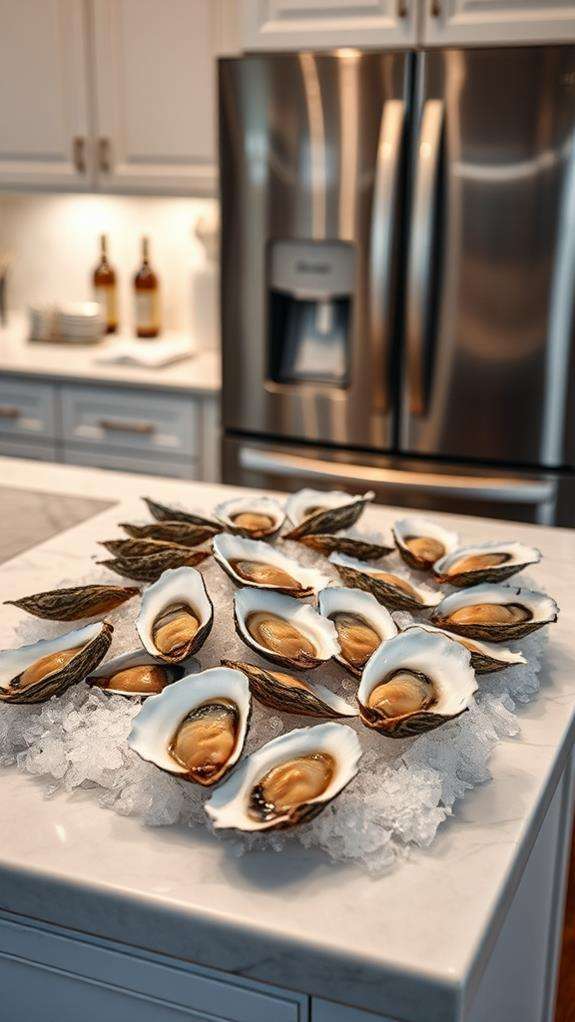
When transporting oysters from the market, you'll want to bring an insulated cooler bag with ice packs to maintain their ideal temperature of 40°F or below during your shopping trip. Before placing oysters in your cart, check that their shells are tightly closed or snap shut when tapped, as this indicates they're still alive and safe to eat. Keep the oysters on ice and try to make the seafood counter your last stop before checkout, ensuring they spend minimal time at room temperature during your shopping journey.
Proper Seafood Transport Tips
Getting fresh oysters home safely requires proper preparation and timing. You'll need to plan your route home and have the right supplies ready before purchasing these delicate shellfish. A proper transport setup guarantees your oysters remain fresh and safe for consumption.
When transporting oysters from the market to your refrigerator, follow these essential steps:
- Pack the oysters in a waterproof container or sealed plastic bag, making sure they're thoroughly cushioned with crushed ice or frozen gel packs to maintain a temperature between 35-40°F
- Position the oysters with their curved side down and deep side up to help them retain their natural juices, and verify they're packed tightly enough to prevent shifting during transport
- Place the container in the coolest part of your vehicle, away from direct sunlight or heat sources, and head straight home without making additional stops
You'll want to minimize the time your oysters spend above refrigeration temperature, so it's imperative to keep your transit time under 30 minutes whenever possible. If you're traveling longer distances, consider bringing a larger cooler with additional ice packs to maintain proper temperature control.
Keep Shells Tightly Closed
Tightly closed shells serve as a vital indicator of oyster freshness and safety. When you're selecting or checking your oysters, you'll want to verify that each shell is firmly sealed, as this shows the oyster is alive and protecting itself from its environment. If you notice any shells that are gaping open or won't close when tapped, you should discard those oysters immediately.
During storage, you'll need to regularly inspect your oysters to confirm they're maintaining their tight seal. Living oysters naturally react to stimuli by closing their shells, which is their primary defense mechanism against threats and temperature changes. When you tap or gently squeeze an oyster, it should respond by tightening its shell – this is what you're looking for as a sign of freshness. You can perform this quick test before refrigeration and periodically while they're stored.
Don't try to keep oysters that have damaged or broken shells, as they won't maintain proper closure and could be contaminated. Remember, a healthy oyster will keep its shell closed until you're ready to shuck it for consumption, using this natural seal to maintain its freshness and safety.
Temperature During Shopping
Maintaining proper temperature kicks off the moment you pick up oysters from the market. You'll need to protect these temperature-sensitive shellfish during transport to guarantee they remain safe for consumption and sustain their peak freshness. The ideal temperature range for oysters is between 35-45°F (1.7-7.2°C), which you'll want to uphold throughout your shopping journey.
To properly manage oyster temperature during shopping:
- Bring an insulated cooler bag with ice packs when you're planning to purchase fresh oysters, guaranteeing the internal temperature stays within the safe range
- Request that the market staff package your oysters with additional ice if you're traveling more than 30 minutes
- Place your oysters in the coolest part of your vehicle during transport, avoiding direct sunlight or heat sources like car vents
Don't leave your oysters in a hot car while running other errands, as temperature fluctuations can compromise their safety and quality. If you're shopping during summer months, consider making oysters your last purchase before heading home. Once you arrive, transfer them immediately to your refrigerator's coldest section to maintain ideal freshness.
Quality Maintenance Tips

For ideal freshness, proper storage techniques play an essential role in keeping your oysters safe and delicious. You'll want to store your oysters cup-side down to help them retain their natural juices, and don't store them in airtight containers or plastic bags, as they need to breathe.
Keep your oysters at a consistent temperature between 35-40°F, and don't let them sit in standing water or melted ice. Instead, place them in a perforated container or colander with a bowl underneath to catch any draining water. Cover them loosely with a damp cloth to maintain moisture without causing them to suffocate.
Don't clean your oysters until you're ready to eat them, as scrubbing them too early can reduce their shelf life. When you do clean them, use a stiff brush to remove any debris, but don't soak them. Check your oysters daily and discard any that have opened shells or smell unusually fishy. You'll also want to avoid stacking them too deeply, as this can damage the shells and cause premature death. If you're storing them on ice, make certain they're not in direct contact with the ice itself.
Frequently Asked Questions
Can Pregnant Women Eat Refrigerated Oysters?
You shouldn't eat raw or undercooked oysters while pregnant, as they can harbor harmful bacteria like Vibrio vulnificus and parasites that pose serious risks to you and your baby. Even refrigerated oysters aren't safe unless they're fully cooked. If you're craving oysters during pregnancy, make sure they're thoroughly cooked until they reach an internal temperature of 145°F (63°C). Canned, smoked, or fully cooked oysters are your safest options.
Do Oysters Continue Filtering Water While Stored in the Fridge?
Here's what's fascinating about those oysters in your fridge: they're not actively filtering water anymore. Once you've removed them from their marine environment, they've entered a state of dormancy. You'll notice they're tightly closed, conserving the seawater they've trapped inside their shells. While they're technically still alive in proper refrigeration, they're not performing their usual filtering functions that make them such effective water cleaners in the ocean.
Why Do Some Oysters Taste Different After Refrigeration?
You'll notice taste changes in refrigerated oysters because they're still living organisms that continue metabolizing, which affects their glycogen (stored sugar) levels. When you refrigerate them, they'll gradually use up their energy reserves, leading to slight alterations in their sweetness and mineral flavors. Additionally, the cold temperature can cause them to release some of their natural liquor (juice), which impacts their briny character and overall taste profile.
Can You Store Different Oyster Varieties Together in the Same Container?
You shouldn't store different oyster varieties together in the same container, as each type has its own distinct salinity level and flavor profile. When stored together, the liquor (natural juice) from different varieties can mix, altering their unique tastes and potentially affecting their quality. It's best to keep each variety separate in mesh bags or containers with proper drainage, and you'll want to label them to maintain their distinct characteristics.
Does Refrigeration Affect the Oysters' Nutritional Content Over Time?
When you refrigerate oysters, their nutritional content remains relatively stable for the first few days. You'll find that proteins, minerals like zinc and iron, and omega-3 fatty acids stay largely intact. However, some vitamins, particularly vitamin C, will gradually decrease over time. While refrigeration slows this process, it doesn't completely stop it. That's why you'll get the most nutritional benefits when you eat your oysters as fresh as possible.





